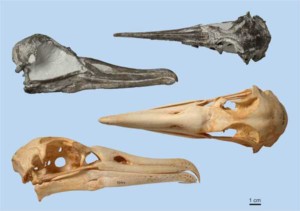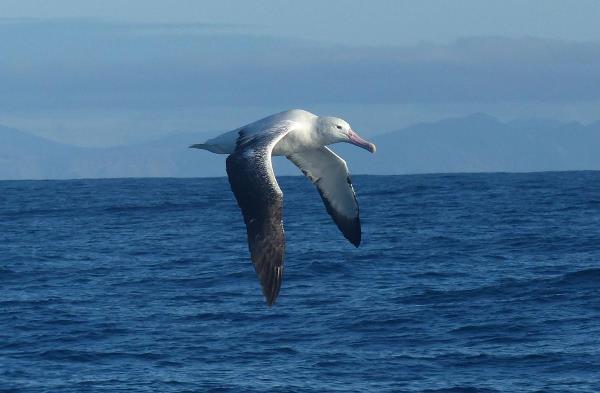LINKED PAPER
A small, narrow-beaked albatross from the Pliocene of New Zealand demonstrates a higher past diversity in the feeding ecology of the Diomedeidae. Mayr, G. & Tennyson, A.J.D. 2019. Ibis. DOI: 10.1111/ibi.12757. VIEW
On the hunt for fossils
In 2011, Alastair Johnson was hunting for fossils on a remote beach in Taranaki, New Zealand. Three million-year-old concretionary mudstone rocks with fossil oysters and scallops are quite common in this area but remains of vertebrates are much rarer and take a trained eye to spot. When eroded bone is seen on the surface of a rock, this is a useful clue but it is still almost always impossible to know what is actually contained within the rest of the rock. Revealing the contents of such rocks requires a great deal of skill, time and patience, not to mention having to lug boulders sometimes kilometres to a vehicle in order to get them to a preparation lab in the first place.
When something magical appears
The rewards of such an exercise are variable – maybe just the crushed fragments of an undiagnostic bone will appear as the rock is meticulously chipped away in a cloud of dust. On rare occasions, however, something magical appears out of the rock and on this occasion it was a peculiar and beautifully preserved skull that appeared before Alastair’s eyes.

Figure 1 Alastair Johnson on the hunt for fossils © Alan Tennyson / Te Papa
Once the skull was in New Zealand’s national museum in Wellington (Museum of New Zealand Te Papa Tongarewa), and after a bit of finishing work from expert preparator Al Mannering, it was able to be compared closely with other skulls.
The comparison with other albatross skulls
It was clearly an albatross skull but two unusual things were immediately apparent: it was very small (smaller than the skulls of all living albatrosses) and its beak was oddly thin (other albatrosses have a broader, more rounded beak).

Figure 2 The fossil skull of the new species (above) in comparison to that of the extant Black-footed Albatross Phoebastria nigripes (below) © © Jean-Claude Stahl / Te Papa, Wellington, New Zealand
Gerald Mayr from the Senckenberg Research Institute and Natural History Museum Frankfurt in Germany and I compared the skull with those of all living and extinct albatross taxa. We concluded that the size of the new fossil was not so unusual in albatross history – some long extinct albatrosses ranging in age from the Eocene to the Miocene epochs were similarly small. However the narrow bill was unique among all known albatrosses, both living and extinct.
What has caused the difference in size and beaks?
So why were some albatrosses smaller in the past and why did some have such narrow beaks?
In our new article, we suggest that albatrosses evolved from smaller relatives, so we might expect some ancient albatrosses to be smaller than the modern ones which can have wingspans up to 3meters wide.
Beaks based on diet
Most albatrosses are predominantly squid eaters, but they also take fish, crustaceans, and various other invertebrates. Usually, narrow beaks in seabirds are found in fish-eaters such as shearwaters, shags, razorbills, and some penguins (such as king penguins). Based on this information, we think that the Taranaki albatross was mainly a fish-eater.
We can only speculate as to why small fish-eating kinds of albatrosses are no longer alive today but competition with a wide range of other seabirds in this size range, such as shags and gannets may be an answer.
 Figure 3 The Southern Royal Albatross Diomedea epomophora (in Cook Strait, August 2017) is the largest seabird alive with a 3 m wingspan © Alan Tennyson / NZ Birds Online
Figure 3 The Southern Royal Albatross Diomedea epomophora (in Cook Strait, August 2017) is the largest seabird alive with a 3 m wingspan © Alan Tennyson / NZ Birds Online
The new fossil skull is the most complete albatross skull ever found but we know very little about the beaks of early albatrosses.
We predict that new fossil discoveries are likely to find that narrow-billed albatrosses were more abundant in the past and that fish-eating was a more common feeding method for ancestral albatrosses.
What have we named the new species?
Given how distinctive the new skull is, we have named it as a new genus and species Aldiomedes angustirostris: The taxon is named in honor of Alastair (‘Al’) Johnson; the second part of the name refers to ‘Diomedes’, the Greek mythological figure, after which the albatross family was named. The species epithet is derived from the Latin ‘angustus’ meaning narrow, and ‘rostrum’ meaning beak.
Nominate this article for a BOU Science Communication Award.
References
Mayr, G. & Tennyson, A.J.D. 2019. A small, narrow-beaked albatross from the Pliocene of New Zealand demonstrates a higher past diversity in the feeding ecology of the Diomedeidae. IBIS. DOI: 10.1111/ibi.12757. VIEW
Image credits
Featured image: The fossil skull of the new species Aldiomedes angustirostris © Jean-Claude Stahl / Te Papa, Wellington, New Zealand




